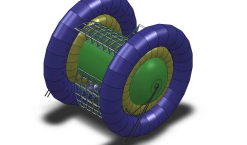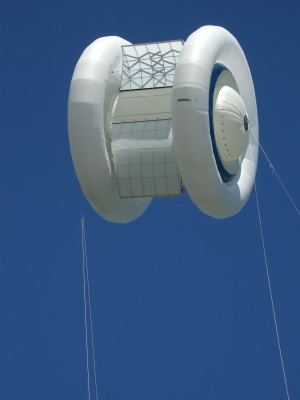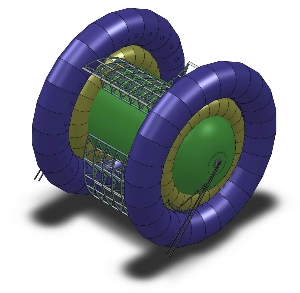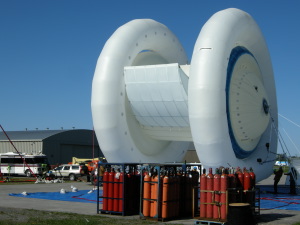
The Sky’s No Limit
By Treena Hein
General Aerospace Aerospace design space explorationMagenn Power's floating MARS turbine brings wind power generation down to Earth

Wind energy, in parallel with Earth’s climate in recent years, has never been hotter. According to the World Wind Energy Association, 5374 MW of new wind-produced power was installed in the first quarter of 2009 in 11 of the top 15 countries using wind, an increase of 23 per cent in the same countries over the same period in 2008.
Wind energy, in parallel with Earth’s climate in recent years, has never been hotter. According to the World Wind Energy Association, 5374 MW of new wind-produced power was installed in the first quarter of 2009 in 11 of the top 15 countries using wind, an increase of 23 per cent in the same countries over the same period in 2008.Globally, Ontario stands out. In June, the WWEA presented its annual World Wind Energy Award to the province, recognizing it as "the leading wind energy jurisdiction in North America." The province boasts almost 1,000 MW of wind capacity, equivalent to the consumption of about a quarter of a million average Ontario households.
Globally, Ontario stands out. In June, the WWEA presented its annual World Wind Energy Award to the province, recognizing it as "the leading wind energy jurisdiction in North America." The province boasts almost 1,000 MW of wind capacity, equivalent to the consumption of about a quarter of a million average Ontario households.

Not everyone, however, favours wind energy. Critics claim it’s too unreliable by its nature and that only a small percentage of locations around the world can consistently supply power. Added to this are charges ranging from the comparatively high cost of building large wind farms to the negative impact turbines have on migrating bird populations.
Fred Ferguson, chief technical officer and founder of Magenn Power Inc. in Ottawa, believes he and his company have come up with a turbine that retains the benefits of wind generation but eliminates its potential downsides.
Called MARS (Magenn Air Rotor System), the turbine is basically an envelope of Dacron-like proprietary fabric material filled with helium and encased in a high-tension net. The ‘balloon’ is airtight, durable, resistant to UV degradation and able to shed ice, rain and snow. As the sail-like blades catch the wind and rotate the unit, the mechanical energy of the spinning blimp is converted to electricity by generators at both ends. The current is then transmitted through copper wire inside the winched tether, and delivered to a transformer for storage or transmission. Dihedral winglets at the lower sides stabilize the turbulent effects of drag and keep the unit steady.
"The Magnus effect — the lift a spinning object generates in a moving fluid like air — adds an increasing and substantial lift force to the net buoyancy," says Ferguson. "This assists furthering lift in increasing winds."
At 600 to 1,000 feet above ground, compared to the 300 or less where turbines generally operate, MARS captures the steady strong wind not always present near the Earth’s surface.

"It’s true that the higher you get off the ground the more consistency you have in terms of wind," says Dr. John Nyboer of Simon Fraser University, the director of the Canadian Industrial Energy End-use Data and Analysis Centre. "[Magenn’s] technology is more efficient than turbines and easier to install."
From Idea to Prototype
An aeronautical pioneer who invented the Magnus airship, Ferguson has served as a consultant for Lockheed Martin, the US government’s ‘Star Wars’ defence program and NASA’s Mars vehicle program. In 2002, he was intrigued by a quirky idea he read about to address California’s brownout problems — generating electricity from propellers on kites. He began brainstorming how a floating electricity generator might work. Patents followed and in early 2004, he founded Magenn.
"I asked myself how a three dimensional turbine in the sky could be engineered," he says. "It could serve during disaster relief and in isolated off-grid locations such as the hundreds of thousands of poor rural villages all over the world."
Patents filed, Ferguson got to work, initially using his own savings. In December 2006, the Canadian government’s Sustainable Development Technology Corporation awarded Magenn a $950,000 grant. Also in 2006, Magenn’s Air Rotor was featured in the Discovery Channel’s Project Earth documentary series which focuses on cutting-edge technologies that address climate change.
"Even with $7 million in business and technology Research & Development spent so far, it’s a little more difficult than developing new airships because we’re breaking new ground," Ferguson says. "Even though MARS looks simple and easy to understand, there were complex problems which took time to overcome."
In terms of overall design, there were three main challenges. "We needed to maintain structural integrity and keep it light, so there was a lot of researching composite materials," Ferguson says. "Secondly, we had to maintain aerodynamic effects to achieve efficiency, and third, we needed to keep it stable in all wind conditions."
Discovery Channel put up half the money to conduct the tests that were critical to creating a prototype. First was an airspeed test in 2006 in Dominican Republic, a well-known spot for wind research because of its constant and steady Easterly Trade Winds.
"We found out that at 1000 feet above ground, the energy you can collect is eight times greater than at 300 feet," Ferguson says. "And at that altitude, the wind is stable. We also found that not much changes when you go above 1000 feet."
The team next traveled to Kentucky in 2007 for tether tests. The tether material had to be flexible with excellent abrasion resistance, while resisting moisture and stretching. The choices came down to steel cable and a tether made of bundled strands of Vectran, one of the strongest plastic composites available.
"A suitable tether needed to hold five cars off the ground, which is about six tons," says Ferguson. "The first car represents the combined weight of the balloon and the tether; the rest are equivalent to the force of drag on the balloon." Steel snapped at three cars, but Vectran suspended all five.
The next trial involved testing a model in a massive wind tunnel owned by General Motors. "Wind speed data collected during the first test was used here," says Ferguson. "The tunnel simulated the forces that would act on a real model up in the sky." As a result of this test, a central rudder disk was added and the blades were angled towards the centre. Later, yaw stabilizers were added to each end.
Ferguson says the current and ongoing development of a full-scale prototype involves assessing the advantages of a ‘clamshell’ blade style that can be opened with compression cylinders, plus advancements in minimizing the yaw structures, which provide directional stability. Magenn’s current engineering and technical team of 12 is also working on other aspects of design, from transportability to electronics.
"We realized we needed a typical airship ballonet, which is an inside air bladder that adjusts envelope pressure in cold and hot temperatures," Ferguson says, "so you don’t over-pressurize and lose helium."
"Currently, in terms of design evolution, we are at the stage where we know the trade-offs well and we can focus on what to do to get the best results," he adds. "We are over the major hurdles to convert wind energy to rotational energy to electricity."
Into the Blue
Once the prototype is finalized, the next step for the company will be a saleable product. The installed cost, including helium, for the company’s current 100 kW MARS unit is about $500,000.
"This compares favourably to 100kW wind turbines, which typically cost more to buy and install," says Anthony Pizarro, Magenn’s director of corporate development. "Plus, turbines are only useful in under 13 percent of locations around the world where wind is strong enough."
By contrast, Magenn’s MARS 100kW is viable in over 45 per cent of the world. "In many places where expensive diesel-generated power is used at $0.50 to $1 per kwh and conventional wind and solar are not viable, MARS provides $0.08 to $0.16 per kwh," says Pizarro. "It could pay for itself in only 3 to 4 years in many cases. This rate is also cheaper than what is offered by 100kW turbines at many good sites."

In testing, Magenn has achieved a coefficient of power that is better than 0.22, which is basically the efficiency of catching wind energy and converting it to rotational power output. "The advantage of the large floating cylinder is the economic efficiency of building such a large unit to catch a massive amount of wind as compared to existing wind turbines," says Ferguson.
Presently, Magenn is considering a 100kW production unit, but Ferguson envisages 1 MW units and, eventually, even those in the 5 MW range. "With airships, bigger is always better from both an efficiency and economics point of view," he explains. "Every time you add a few percentages to the overall size, the lifting factor goes up cubically. If a MARS unit is too small, you need more buoyancy and you have a lot less flexibility with weight. In larger units, you can use cheaper, lighter materials."
"Also, because it’s a three-dimensional structure, you can build a much bigger structure than you can with a 2-D wind turbine, and still achieve good structural integrity," he adds. "[Traditional] turbines have definite size limitations."
The company is currently building an advanced 30kW demonstration prototype in Gatineau, Quebec which will be operational by the end of this year. "That size could be mass-produced as well," Ferguson says. "This one will be used for an extended period in a developing country, possibly providing power for some of a village’s needs."
www.magenn.com
